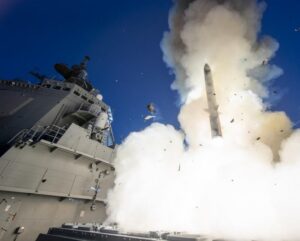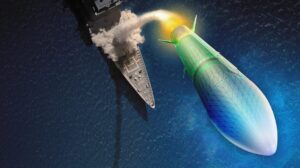The director of the Missile Defense Agency (MDA) this week confirmed the Defense Department is exploring cooperatively developing and producing hypersonic defense missiles, akin to their shared work on the Standard Missile(SM)-3 Block IIA.
“We’re using the same model for our cooperation with Japan as we use with the SM-3 Block IIA program, which was a cooperative development with Japan. So the easy way to go with Japan is to offer up propulsion stacks, because they build the second stage and the third stage on the SM-3 Block IIA today. And we’re in production right now. We’re delivering those around the globe now. So that’s the easy way to go,” Vice Adm. Jon Hill told reporters Wednesday during the annual McAleese Defense Programs conference.

In 2021, MDA first awarded contracts to Raytheon Technologies [RTX], Northrop Grumman [NOC] and Lockheed Martin [LMT] to develop and refine their respective concepts for a Glide Phase Interceptor (GPI) hypersonic missile defense system (Defense Daily, Nov. 22, 2021).
Then, last year, MDA down-selected to Raytheon and Northrop Grumman to continue refining and developing their concept work into 2023 (Defense Daily, June 24, 2022).
Assistant Secretary of Defense for Space Policy John Plumb last November said the two countries were looking to expand cooperation to hypersonic defense during a Center for Strategic and International Studies event on the 2022 Missile Defense Review.
Given their success in cooperative development and production on SM-3 IIAs, “Japan has now publicly expressed some interest in working with us on countering hypersonics and I think that’s the next natural evolution…so I hope that’s a thing we can continue and I think both nations have expressed interest in doing that,” Plumb said at the time.
Hill said in discussions with Japan on GPI they “would like to get a little more into, say, the front end of the missiles. So we’re looking for common parts – we have two companies going for this. This is where the challenge is, when you’ve got two in play, that means Japan has to sign up to do two different designs, knowing that one of them may be a throwaway. But that’s also what U.S. industry signed up to do, right, they know one of them is going to go away downstream.”
He said he does now know when the final down-select on GPI design and production will happen, but it will be dependent on how well they mature technically.
Hill said MDA has an Executive Steering Council (ESC) in Japan right now, which visits on a regular basis annually to talk with the Japanese government about cooperative development of GPI.

“My team is there right now doing the technical interchange. And so this is when we sit down with the Japanese Government across the maritime staff organization with their ATLA organization, their Acquisition Technology and Logistics Agency. Well, we’ll do ATLA, and then we have their bureau of defense buildup. Start meeting with them right now as we speak, and then we’ll come back, take a breather, then we’ll go back out and we’re going to bring industry with us the next time around so that we’re not just speaking for industry saying, ‘hey, we’re going to offer up this piece/part for Japan components.’”
Hill said he wants the U.S. industry to say they need and want Japanese participation in GPI production, “so in a perfect world, we would have industry basically subcontract with a Japanese company to do that.”
However, he said if industry does not choose to use Japanese subcontractors for certain parts, the government will repeat the SM-3 IIA program process, “which is we direct the American company to go subcontract. So there’s different ways to do it. But right now we’re exploring the opportunity to just identify what those cooperative development areas would be.”
Hill also described how the GPI system aims to work, focusing on intercepting hypersonic weapons in “that wide area and layer that goes into glide phase. So when you look at a hypersonic threat, they boost up and then they glide, and that’s where they maneuver around the globe, and they dive back in for the killing. So sea-based terminal [defense] is that lower terminal phase; glide phase is meant to take it out when it’s in that slow roll maneuver, that’s when it’s the most vulnerable is in the glide phase, so that’s Glide Phase Interceptor.”
In 2021 MDA first announced it was revamping its previous counter-hypersonic missile defense program, the Regional Glide Phase Weapon System, into a nearer-term GPI initiative while separately researching longer term capabilities (Defense Daily, Feb. 4, 2021).